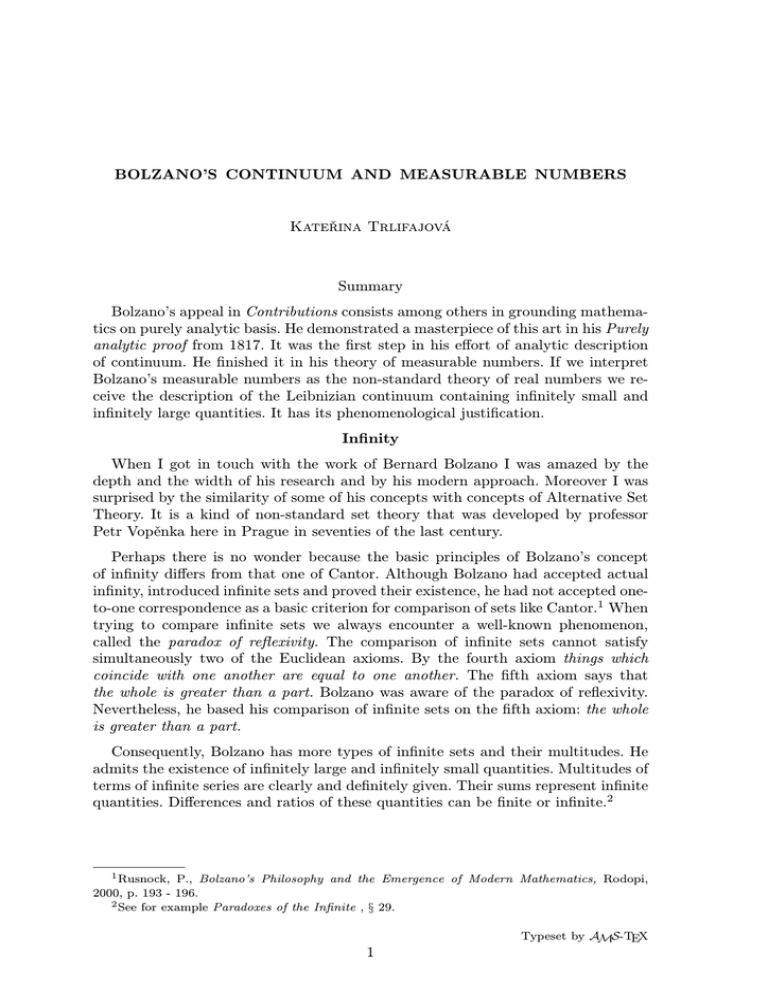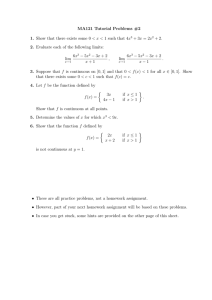BOLZANO’S CONTINUUM AND MEASURABLE NUMBERS Kateřina Trlifajová Summary
advertisement

BOLZANO’S CONTINUUM AND MEASURABLE NUMBERS
Kateřina Trlifajová
Summary
Bolzano’s appeal in Contributions consists among others in grounding mathematics on purely analytic basis. He demonstrated a masterpiece of this art in his Purely
analytic proof from 1817. It was the first step in his effort of analytic description
of continuum. He finished it in his theory of measurable numbers. If we interpret
Bolzano’s measurable numbers as the non-standard theory of real numbers we receive the description of the Leibnizian continuum containing infinitely small and
infinitely large quantities. It has its phenomenological justification.
Infinity
When I got in touch with the work of Bernard Bolzano I was amazed by the
depth and the width of his research and by his modern approach. Moreover I was
surprised by the similarity of some of his concepts with concepts of Alternative Set
Theory. It is a kind of non-standard set theory that was developed by professor
Petr Vopěnka here in Prague in seventies of the last century.
Perhaps there is no wonder because the basic principles of Bolzano’s concept
of infinity differs from that one of Cantor. Although Bolzano had accepted actual
infinity, introduced infinite sets and proved their existence, he had not accepted oneto-one correspondence as a basic criterion for comparison of sets like Cantor.1 When
trying to compare infinite sets we always encounter a well-known phenomenon,
called the paradox of reflexivity. The comparison of infinite sets cannot satisfy
simultaneously two of the Euclidean axioms. By the fourth axiom things which
coincide with one another are equal to one another. The fifth axiom says that
the whole is greater than a part. Bolzano was aware of the paradox of reflexivity.
Nevertheless, he based his comparison of infinite sets on the fifth axiom: the whole
is greater than a part.
Consequently, Bolzano has more types of infinite sets and their multitudes. He
admits the existence of infinitely large and infinitely small quantities. Multitudes of
terms of infinite series are clearly and definitely given. Their sums represent infinite
quantities. Differences and ratios of these quantities can be finite or infinite.2
1 Rusnock,
P., Bolzano’s Philosophy and the Emergence of Modern Mathematics, Rodopi,
2000, p. 193 - 196.
2 See for example Paradoxes of the Infinite , § 29.
Typeset by AMS-TEX
1
2
KATEŘINA TRLIFAJOVÁ
Intuition
In the last part of Contributions , Bolzano had taken polemic with Kant. He
provided a refutation of Kant’s doctrine of the construction of objects in intuition
and he declared a program of grounding mathematics on a purely analytic basis.3
He accepts the Kant’s difference between analytic and synthetic judgements. He
investigates very thoroughly the question of the basis of synthetic judgements. It is
an intuition for Kant. For Bolzano, . . . all this seems to me to rest on a distinction,
which is not clearly enough thought out, between that which is called ‘empirical,
’and that which is called ‘a priori ’in our cognitions.
By the principle of sufficient reason, I am of course, bound to look for a certain
basis for all my judgements. This is a quite different one for the empirical judgements than for the a priori ones. The former, the so-called judgements of reality,
have the characteristic, that I seek their basis in that which is, (in something real,
in things) and indeed, according to circumstances, partly in that which I call, the
‘particular nature of my perceptive faculty, ’and partly in certain ‘things different
from me, i.e. external things ’, which ‘affect my perceptive faculty. ’This is not the
case with my ‘a priori judgements, ’for which I can assume that the basis on which
I attribute the predicate to the subject, cannot possibly lie anywhere other than in
the ‘subject itself. ’ 4
In the both cases, Bolzano refuses that intuition is that basis. For empirical
judgements, it is that ‘which is, ’and for a priori judgements it is rather a general
concept. There is no justifiable distinction between empirical and a priori concepts.
I would like to demonstrate Bolzano’s approach in the case of continuum. This
concept can be considered as both empirical and a priori.
Continuum
The concept of continuum and its arithmetical (or analytic) description was for
Bolzano one of the most challenging problems. He devoted a great effort to its
formalization.
From the beginning, he considered it as being composed from innumerably
points. Already in Contributions he writes: For obviously, the straight line, the
plane are objects of a composite kind, in which, we imagine, for instance, innumerably many points as well as particular relationship which these points must have
to some given ones.5
Much later, in Paradoxes of the Infinite, Bolzano’s concept is more elaborate.
Continuum is temporal, spatial, or material. He considers them all together in the
following text.
It is very well known that everything extended, according to its concept, must be
composed of parts; . . . which have no extension and are absolutely simple (points in
time, or space, atoms, i.e. simple substances in the universe in the realm of reality).
3 Rusnock,
P., Bolzano’s Philosophy and the Emergence of Modern Mathematics, Rodopi,
2000, p.45.
4 Contributions to a Better-Grounded Presentation of Mathematics, § 5, 6, in Russ, S., The
Mathematical Works of Bernard Bolzano, Oxford University Press, 2004.
5 Contributions, II. § 5.
BOLZANO’S CONTINUUM AND MEASURABLE NUMBERS
3
Finally, Bolzano defines continuum with the help of distances of points. In other
words, with help of a metric, i. e. the function to real numbers. In fact, Bolzano
transfers the structure of real numbers to continuum.6 Bolzano did not use real
numbers, but he constructed his own measurable numbers.
We cannot help defining continuum to exist where, and only where, a collection
of simple objects (of points in time or space or even of substances) occurs which are
so arranged that every single one of them has at least one neighbor in this collection
at every distance however small.7
Measurable numbers
It is likely that Bolzano had the special concept of infinity we wrote about in mind
when he created his theory of measurable numbers: if natural numbers constitute a
well-defined infinite set with an exact multitude of terms, then we can define infinite
quantity concepts to be constituted by the same infinite multitude of arithmetic
operations.
Let us briefly recall the main ideas of Bolzano’s theory of measurable numbers.8 Bolzano treats rational numbers as number concepts in which there is a
finite multitude of arithmetic operations of addition, subtraction, multiplication
and division. In infinite number concepts, an infinite multitude of arithmetic
operations occur. An expression representing such a concept is an infinite number
expression.
Bolzano’s examples of infinite number expressions are as follows:
1 + 2 + 3 + 4 + ... in inf.
1 1
−
2 4
1
(1 − )(1 −
2
1
1
−
+ ... in inf.
8 16
1
1
1
)(1 − )(1 − )... in inf.
4
8
16
b
,
a+
1 + 1 + 1 + ... in inf.
+
where a, b is a pair of whole numbers.
Infinite number concepts can be quite complicated. Bolzano uses the so-called
measuring fractions for an investigation of their characteristics.
There are three possibilities for an infinite number concept S:
1. S is a measurable number if for every positive natural number q there are
a whole number p and two positive number expressions9 P1 and P2 , the former
6 Sebestik,
J., 1992. Logique et mathématique chez Bernard Bolzano. Librairie Philosophique
J.Vrin, Paris 1992, p. 66.
7 Paradoxes of the Infinite, § 38, in Russ, S., The Mathematical Works of Bernard Bolzano,
Oxford University Press, 2004.
8 Russ, S.,The Mathematical Works of Bernard Bolzano, Oxford University Press, 2004, p. 357
- 428.
9 Bolzano does not say what is a positive number expression. Nevertheless, previously he defined
a positive number expression as being equivalent to an expression requiring only positive numbers
without using subtraction and any other equal expression. See Sebestik, J., 1992. Logique et
mathématique chez Bernard Bolzano. Librairie Philosophique J.Vrin, Paris, 1992, p. 362
4
KATEŘINA TRLIFAJOVÁ
possibly being zero such that the following equations are satisfied:
S=
p
p+1
+ P1 =
− P2 .
q
q
Infinitely small numbers are a special sort of measurable numbers. S is infinitely
small positive if for any positive whole number q there is a positive number
concept P such that10
1
S = − P.
q
S is infinitely small negative if −S is infinitely small positive.
2. S is infinitely large if for any positive q there is a whole number p such that
one of the equations:
p+1
p
− P2
S = + P1 S =
q
q
is satisfied, but there is no p satisfying both equations.11
Bolzano obviously liked the idea of measurable fractions. It would be simpler
and clearer to define infinite numbers as the number concepts S such that for any
whole number N there is a positive number expression P such that the equation
S = N + P , resp. S = −N − P , is satisfied. This is indeed an equivalent definition,
and Bolzano proves it immediately as a theorem.12
3. There exist number concepts S that are neither measurable nor infinitely
large. For instance S = 1 − 1 + 1 − 1 + 1 . . . in inf.13
Bolzano proves many theorems about number concepts: The sum and the product
of two infinitely small numbers is infinitely small. The sum of two infinitely large
numbers of the same sign and the product of two infinitely large numbers is infinitely
large. The sum of a measurable and an infinitely large number is infinitely large.
The sum of a measurable and an infinitely small number is measurable. The sum
and the product of two measurable numbers is a measurable number.
Measurable numbers form the base. Bolzano defines a structure having all the
necessary properties of real numbers by introducing the relationships of their equality (or equivalence as Bolzano calls it) and of their order. Bolzano’s first definition
of equality was not correct but he was clever enough to add note where he revised
it himself.14
10 For
instance
S=
11 Examples
1
1 + 1 + 1 + ... in inf.
of infinitely large positive and negative number concepts are the following:
S = 1 + 2 + 3 + ... in inf., S = −1 − 2 − 3 − ... in inf.
12 Russ,
2004, p.374.
§32 of Paradoxes of the Infinite, Bolzano gives necessary conditions for summability of
infinite series: it is the associativity and commutativity of terms.
14 Russ, 2004, p.391.
13 In
BOLZANO’S CONTINUUM AND MEASURABLE NUMBERS
5
By the new corrected definition, two measurable numbers A, B are equal (equivalent) , A ≡ B, if their difference A − B considered in its absolute value is
infinitely small. This equality is reflexive, symmetric and transitive, and compatible
with arithmetic operations. In fact, Bolzano introduces a factorization of measurable
numbers, in modern terminology. From now on, he works with equivalence classes.
He does not, however, distinguish between the old class of measurable numbers and
the new factor-class. He calls both of them measurable numbers.
He introduces the ordering of measurable numbers. If the difference A − B
of two measurable numbers A, B is not infinitely small and it is positive then we
say that A is greater than B, A > B. Bolzano proves linearity, transitivity and
density of this ordering.
The last requirement is the completeness. Bolzano can finally prove the desired
theorem that every Bolzano-Cauchy sequence of measurable numbers has a limit
that is a measurable number. Although his proof lacks some final demonstrations,
it is almost entirely correct and successful.15
Consequently, he can also prove the theorem about the existence of a supremum
and an infimum of a set of measurable numbers. He did it already very elegantly
in his Purely analytic proof in 1817,16 and he repeats that proof here. Thus, Bolzano’s measurable numbers equipped by equality have all desired properties of real
numbers.
Bolzano’s (new) measurable numbers are thus linearly ordered, dense, and the
supremum theorem (Bolzano-Cauchy theorem) is valid.
Interpretation of measurable numbers
Bolzano’s theory is usually interpreted within the standard (Cantor) theory of
real numbers.17 Bolzano’s infinite number concepts are represented by sequences
of rational numbers. There is a consensus that Bolzano’s concept of measurable
numbers is more or less inaccurate attempt to create a rigorous theory of real
numbers. Nevertheless, in this interpretation, there is no place for infinitely large
and infinitely small numbers. The richness of measurable numbers is lost.
Infinite number concepts have a stable multitude of elements too, and they represent uniquely given quantities.
Lakatos in his paper about the significance of Cauchy for the analysis of continuum recalls also Bolzano: It is a most interesting historical fact that Bolzano, the
best logical mind of the generation, made a real effort to clarify matters. He was
possibly the only one to see the problems related the difference between the two continuums: the rich Leibnizian continuum and, as he called it, its ’measurable’ subset
- the set of Weierstrassian real numbers. Bolzano makes it very clear that the field
of ’measurable numbers’ constitutes only an Archimedean subset of a continuum
enriched by non-measurable - infinitely small or infinitely large - quantities. The
editor made a misguided attempt to reconstruct Bolzano’s theory as a mere precursor of Cantot’s theory of real numbers; . . . No doubt, since Robinson has shed
15 Rusnock,
p. 186 - 188.
2000, p. 269
17 The only exception is Berg who compares Bolzano’s approach with Robinson’s non-standard
analysis.
16 Rusnock,
6
KATEŘINA TRLIFAJOVÁ
new light on the latter, historians will approach the Bolzano manuscript with new
eyes and the relation between Bolzano’s measurable numbers and non-measurable
quantities and Robinson’s standard and non-standard numbers will be clarified.18
Bolzano’s use of infinitely small and infinitely large quantities naturally leads to
the question of a possible interpretation of his theory in a non-standard theory of
real numbers.19
Interpretation in Alternative Set Theory
In my opinion, the most faithful interpretation of Bolzano’s theory appears in
the Alternative Set Theory (AST). This theory is less well-known. It was created
by Petr Vopěnka in Prague around 1979.20 I will explain very briefly some of its
basic principles.
Perhaps the most important contribution of AST is its phenomenological approach. The concept of infinity is based on the notion of a horizon represented by
so-called semisets. AST employs two types of natural numbers, the finite natural
numbers N and all natural numbers N ∗ . Finite natural numbers are ‘small, ’they
are ‘in front of the horizon ’. The class N is a typical example of a semiset, it has
vague boundaries.
N ⊆ N∗
Both N and N ∗ form models of Peano arithmetic, it is axiomatically given.
Infinite natural numbers are natural numbers which are not finite N ∗ − N . They
are ‘beyond the horizon,’.
Finite rational numbers Q are constructed as the quotient field from finite
natural numbers N by the usual way. Rational numbers Q∗ are constructed in
the same way from N ∗ . Rational number x is infinitely small , x ∈ Qi , if it is
less than all inverses of finite numbers. Rational number x is bounded , x ∈ Qb , if
it is smaller than some finite natural number For instance, finite natural numbers
are bounded, the inverses of infinite natural numbers are infinitely small. While
infinite numbers are ‘beyond the horizon of the distance ’, infinitely small numbers
are ‘beyond the horizon of the depth.’
Q ⊆ Q∗
Qi = {x ∈ Q∗ ; (∀n)(n ∈ N )(|x| <
1
)}
n
Qb = {x ∈ Q∗ ; (∃n)(n ∈ N )(|x| < n)}
18 Lakatos,
I., Mathematics, Science and Epistemology, Philosophical Papers, Cambridge University Press, 1978, p. 53
19 Infinitesimals have been entirely excluded in Cantor’s and Dedekind’s theory of real numbers.
Cantor did not like the idea of infinitesimals, he tried to prove their non-existence, he marked
them as infinitary Cholera-Bacillus of mathematics. Also his continuum hypothesis would have
been more complicated by admitting infinitesimals as a new sort of numbers sandwiched between
the rational and irrational numbers. See Dauben, J.W., Georg Cantor - His Mathematics and
Philosophy of the Infinite, Princeton University Press, 1990, p. 131, 233.
20 Vopěnka, P., Mathematics in the Alternative Set Theory, Teubner, Leipzig, 1979
BOLZANO’S CONTINUUM AND MEASURABLE NUMBERS
7
Qi ⊆ Qb ⊆ Q∗
Two elements of Q∗ are indiscernible, if their difference is infinitely small. We
.
can prove that the indiscernibility relation = is an equivalence relation. The classes
of this equivalence are called monads. If x, y ∈ Q∗ then
1
.
(x = y) ⇔ (∀n ∈ N )(|x − y| < )
n
.
M on(x) = {z ∈ Q∗ ; z = x}
.
If we make the factorization of Qb modulo =, we obtain the field of real numbers.
Every real number is represented by a monad of rational numbers.
.
R = (Qb / =)
Rational numbers are the underlying structure constructed by our reason. Real
numbers represent points of a line, related to our perception. When we say the number π, we usually consider an approximate rational number. Thus π is represented
by a monad of rational numbers differing from π ’indiscernibly’ for our purpose.
Formally, Vopěnka’s construction is similar to the non-standard construction of
reals from rationals. He uses semisets rather than ultrafilters. His construction is
simpler and more clear.
The interpretation is now direct and simple. Bolzano’s rational numbers correspond to Vopěnka’s finite rational numbers Q. Infinite number concepts correspond
to the rational numbers. Infinitely small and infinitely large numbers have indeed
the same name in both models. They are defined in nearly the same way. Bolzano’s
equality is defined exactly as Vopěnka’s indiscernibility. Factorizing modulo this
relation we obtain the real numbers R.
Bolzano’s theory
positive whole numbers
rational numbers
infinite number concepts
measurable numbers
infinitely small numbers
infinitely large numbers
equality of measurable numbers
measurable numbers with equality
Alternative set theory
finite natural numbers N
finite rational numbers Q
rational numbers Q∗
bounded rational numbers Qb
infinitely small numbers Qi
infinitely large numbers Q − Qb
.
indiscernibility =
real numbers R
Phenomenological continuum
We see the world surrounding us as being continuous. It seems to be a typical
human property to perceive objects as being continuous if it is at least a bit possible.
Leibniz says: Natura non facit saltus.
Our comprehension of continuum is based on the connection of the objective
and subjective point of view. The indiscernibility relation enables us to express this
double character of continuum. Nevertheless, even this relation of indiscernibility
can be described objectively - for instance with help of measuring fractions.
8
KATEŘINA TRLIFAJOVÁ
For the description of any continuum we use an mathematical structure, for
instance a Cartesian system of coordinates for space, exact clock for time, etc. We
can underlie this structure under the continuum. At the same time, we perceive
that some coordinates are indiscernible, their distance is not measurable.21
If we connect these two points of view we obtain a complete description of continuum. We can speak about monads which are exactly ‘on the horizon ’of our
perception. We can describe continuum as being composed from innumerably monads.
*
*
*
I think that this concept of continuum is partially hidden also in the structure
of Bolzano’s measurable numbers. Infinite number concepts play the role of the underlying structure. The equality (equivalence) of measurable numbers means their
indiscernibility - their distance is not measurable. Bolzano speaks often about the
process of measuring.
I want to take into consideration only their (of numbers) behaviour in the process of measuring, or to speak more precisely, only the nature of their measuring
fractions.22
The corrected definition of equality of measurable numbers says: If the pair of
numbers A and B have a difference A−B which, considered absolutely, has the same
charcteristic as zero itself in the process of measuring, then we say that A = B.23
New measurable numbers are constructed as monads of infinite number concepts.
They represent points of space. They have all desired property of real numbers.
Exactly as Bolzano says about continuum:
Points are simple parts of space, they therefore have no boundaries, no right and
left sides. If one had only a part in common with the other then it would be absolutely
the same as it, and if it is to have something different from it, then both must lie
completely outside one another and there must therefore be space for another point
lying between them. Indeed because the same holds of these intermediate points in
comparison with those two, [there is space] for an infinite set of points.24
21 Only
thanks to our disability to distinguish some elements of the underlying structure we
perceive continuum as being continuous.
22 Infinite Quantity Concepts, § 56.
23 Infinite Quantity Concepts, § 54.
24 Paradoxes of the Infinite, § 38.



